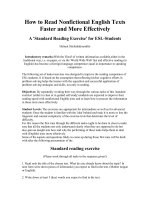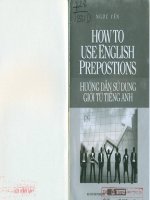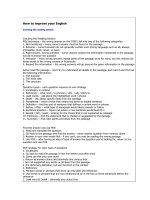HOW TO ADAPT MATERIALS ENGLISH COURSEBOOK10
Bạn đang xem bản rút gọn của tài liệu. Xem và tải ngay bản đầy đủ của tài liệu tại đây (82.44 KB, 11 trang )
SỞ GIÁO DỤC ĐÀO TẠO VĨNH PHÚC
TRƯỜNG THPT TRẦN HƯNG ĐẠO
CHUYÊN ĐỀ HỘI THẢO
“ HOW TO ADAPT MATERIALS- ENGLISH COURSEBOOK10”
Giáo viên: Đào Thị Hường
Trường : THPT Trần Hưng Đạo
Đối tượng: Lớp 10
Số tiết dự kiến: 03
NĂM HỌC 2018- 2019
CHUYÊN ĐỀ:
“HOW TO ADAPT MATERIALS”
(By Dao Thi Huong- Tran Hung Dao High School)
A. INTRODUCTION:
English is considered as an interenational language these days. It has been
used in different aspects of life and has an important role in developing the good
relationship and mutual understanding among countries around the world. In Viet
nam, English is a compulsory subject at every kind of schools of the education
system. It is also a core one that must be taken in almost all important
examinations. With the hope that English will soon become the sencond language
used in daily activities, the government- specially The Ministry of Education has
made every effort to introduce new course books to meet the demand of teaching
and learning English at schools.
However, “ no one size fits all”. In fact, no course book will totally be suited
to a particular teaching situation. The teacher will have to find his own way of
using it and adapting it if necessary. So we should not be looking for the perfect
course book which meets all our requirements, but rather for the best possibe fit
what the book offers and what we as teachers and students need.
Therefore, I study this topic with the ambition to introduce some ways of
adapting materials that may be useful for myself and other teachers in teaching
English at school.
B. CONTENT:
I. Teaching materials:
1. What are teaching materials?
* Teaching materials are the resources a teacher uses to deliver instruction.
Each teacher requires a range of tools to draw upon in order to assist and support
Ss learning.
* According to Spratt, Pulverness and Williams( 2005), materials are what
we use in the classroom to present and practice language, and to develop learners’
language skills including a student’s book, a teacher’s book and audio/ video
recordings. Often ther’s a workbook or activity book ( a book with extra practice
materials), and there may also be a CD- ROM or extra material on a website.
* Tomlinson(2001) defines “materials” as anything which can be used to
facilitate the learning of a language. They can be linguistic, visual, auditory or
kinaesthetic, and they can be presented in print, through live performance or
display, or on cassette, CD- ROM, DVD or the internet.They can be instructional,
experiential, elicitative or exploratory, in that they can inform learners about the
language, they can provide experience of the language in use, they can stimulate
language use or help learners to make discoveries about the language for
themselves. By all means, “instructional materials generally serve as the basis for
much of the language input learners receive and the language practice that occurs
in the classroom”( Richard, 2001, p.251)
2. Coursebooks and its roles:
2.1. Definitions:
Coursebooks are usually published along with a number of supplementary
componets.
- Student’s book
- Teacher’s book
- Practice book
- Grammar and vocabulary workbook
- Diskette
- CD-ROM
- Video
- Resource book
- Business Resource Pack
2.2. Role of coursebook:
- A resource for presentation materials
- A source of activities for learners practice and communicative interaction.
- A reference source
- A resource for self- access work
- A syllabus
- A support for less experienced teachers
2.3. Why teachers use textbooks:
- Extremely difficult to develop materials
- Time- consuming and demanding process to develop new materials
- Teachers have limited time
- Textbooks lessen preparation time, provide ready- made activities and concrete
samples of classroom progress through which external stakeholders can be
satisfied.
3. Materials- “ No one size fits all”
- No course book will totally be suited to a particular teaching situation. The
teacher will have to find his own way of using it and adapting it if necessary. So
we should not be looking for the perfect course book which meets all our
requirements, but rather for the best possibe fit what the book offers and what we
as teachers and students need.
- According to Ansary and Babari (2002), there are 3 options for teachers:
+ Teachers need and use textbooks
+ Teachers don’t need and use textbook. They produce their own materials
+ Or teachers select a textbook and suppement some other materials to perfect it.
4. Materials development:
“Materials development” refers to all the processes made use of by practitioners
who produce and/ or use materials for language learning, including materials
evaluation, their adaptation, design, production, exploitation and research. Ideally,
all of these processes should be given consideration and should interact in the
making of language- learning materials.
II. Materials adaptation
1.Introduction:
We may not be able to choose our coursebook, but we can still make choices about
what materials in it to use. Decisions about whether- and how- to use the
coursebook or part of it will depend on the answers to a number of questions such
as:
- Is the material visually attractive?Is it visually clear( colours, fonts, heading etc.)?
Does the visual material helps the learnersto understand context and meaning?
- Is it well organised?
- Is it culturally appropriate? Is it familiar to learners?
- Is it suitable for the learners’ age, gender, experience, and personal interests of the
learners?
- Is it at the right level?
- Does it give learners enough chances to use the language?
2. Ways to adapt materials:
There are a number of ways to adapt material that is not suitable for a particular
teaching situation. Here are some ideas:
Strategies
* Extending
materials
Problems
- The task or exercise is too
short
- The learners need more
Possible solutions
- Write extra items, following
the same pattern
* Shortening
materials
practice
- The task or exercise is too
long
- The learners don’t need so
much practice
*Changing the
form of tasks
- Use as much as you need, but
do not feel you have to use it
all.
- Give different parts of the text
or task to different learners
- Change the interaction
pattern.
- The task doesn’t suit the
learners’ learning style
- You want a change of pace
- The coursebook often repeats
the same kind of task
*Changing the
- The text or tasks are too easy - Make material more
level of the
or too difficult
challenging, eg. Learners try to
material
answer comprehension
questions before reading
- Make materials less
challenging, eg. break up a
long text into shorter sections.
* Reordering
- The activities in the units in - Change the order of the
materials
the book always follow the
material such as ask learners to
same sequence.
cover up a page or part of a
- The leaners need to learn or page, so that they focus on
practice things in a different
what you want them to do first.
order.
*Making the use - There is not enough practice - Use extra material from the
of all the
material in a particular unit.
book: grammar summaries,
resources in the - The learners need to revise
word lists, lists of irregular
book
particular items.
verbs, etc.
- You want to preview
- Give whole- book tasks such
material in a future unit
as searching through the book
for texts, pictures, language
examples.
III. Practice on Materials Adaptation:
III. 1. Unit 4- For a better community - Getting started (English book 10)
Activity 1: Follow the course book
Activity 2: Read the conversation again and answer the questions:
- Follow the three first questions:
1. When did Quan call Hieu?
2. What was Hieu doing when Quan called?
3. Was Hieu successful as a volunteer teacher there?
Activity 3: Read the dialogue and fill in the blanks with suitable expressions in the
box and then practice reading the dialogue in pairs.
1. That’s sounds great
An:
2. Not really
3. ..by chance
4.Well,
Daddy, I’ ve got a surprise for you.
Daddy: Really? What’s that?
An:
….., I was chosen to be a volunteer this summer in Vinh Phuc Province.
Daddy: …….! Did your teacher offer you the job?
An:
……. I got it ……… I saw an advertisment online, I applied and they
accepted me.
Daddy: Good! I’m sure you will have a meaningful summer.
An:
Thanks, Dad!
Activity 4: Discussion( extra activity)
Work in groups and make a list of volunteer works you can do to help other
people.
III.2. Unit 4- For a better community - Reading (English book 10)
Activity 1: You are going to read a text about the reasons why people volunteer.
Before you read, tick the reasons you thinks you may find in the text.( Follow the
course book)
Activity 2: Read the text and check if your predictions are correct.
( Follow the course book)
Activity 3: Read the text again and decide whether the following statements are
True (T), False (F).
(Changing the level of the material- Make materials less challenging)
People volunteer for a number of different reasons. One of the
more obvious reasons why people volunteer is because they find something they
are passionate about and want to do something good for others. People who
volunteer in their community have a personal attachment to the area and want to
make it a better place for themselves and for others. Many people who volunteer
think that they are very fortunate to live the way they do and want to give
something back to society, as a way of balancing the scales.
Many people choose to volunteer because of the personal benefits that
volunteering has on their character. Indeed, a volunteer often says that the
experience has made him or her a better person. In most cases, volunteers also
become more concerned and aware of the problems facing the world and many feel
that they were ignorant or narrow-minded before.
Volunteer work is a great way to gain experience in a broad range of
fields. You can gain experience in education, social work, health care, marketing,
and web design… The opportunities are endless. Volunteering is a great way to put
in a little of your time and gain some valuable skills, whether professional or
practical.
Volunteer work can often lead to a paying job. Volunteers can try out a field
to see if it suits them and also show that they are dedicated enough to work for
free in the hope that it may lead to a paid job. English teaching is a great example
of a volunteer job that often turns into a career.
T
F
1. Volunteering can contribute to make the community a
better place.
2. People choose to volunteer because of its financial benefits.
3. Many volunteers think they used to be ignorant or narrowminded.
4. Volunteer works may provide you with knowledge of
different fields
5. A volunteer job always turns into a career in the future.
Activity 4: Look at the highlighted word in the text and choose the correct
meaning.(Changing the level of the material- Make materials more challenging)
Origin
Adaptation
1. obvious
A. clear
B. unclear C. important
2. fortunate
A. unlucky B. lucky
C. wealthy
3. concerned
A. tired
B. bored
C. worried
4. narrow – minded
A. open to different people
B. not open to different opinions
C. open to different opinions
5. dedicated
A. devoted
B. excited C. interested
1. obvious
A. clear
B. obscure C. important
2. fortunate
A. unhappy B. lucky
C. wealthy
3. volunteers
A. workers
B. farmers
C. helpers
4. narrow – minded
A. open to different people
B. not open to different opinions
C. open to different opinions
5. dedicated
A. devoted
B. excited C. interested
III.3. Unit 4- For a better community – Looking back and project (English
book 10)
* Looking back:
Activity 1: (Pronunciation)
Listen and circle the words you hear in the sentences( follow the coursebook)
Activity 2: (Vocabulary)
Choose the words from the box to complete the following sentences ( follow the
coursebook)
Activity 3: Grammar
Write the sentences. Use the past simple or the past continuous form of the verbs
( follow the coursebook)
Activity 4: Read the text about Tilly Smith and choose the best answer from
question 1 to 4.
( Changing the level of the material- Make materials less challenging- Shortening)
FROM A GEOGRAPHY LESSON TO A REAL LIFE EXPERIENCE
Tilly Smith was born in 1994. She came from Surrey, England. At school,
she was very interested in her Geography classes. On 6 th December, 2004 Tilly was
having a holiday with her family in Thailand when she realized that Geography not
only an interesting school subject but also helped to save people’s lives.
While Tilly was sitting on Maikhao Beach in Puket, Thailand, the sea water
suddenly receded from the shoreline. Tilly recognised the symptoms of a tsunami
because two weeks before her holiday she learnt about tsunamis in a Geography
lesson from her teacher at school. Tilly wated to leave the beach quickly because
she knew what was happening, but the people on the beach didn’t seem to care.
She was very worried and told her parents about it immediately.
When Tilly’s father warned others on the beach and the staff at the
hotel where they were staying about the possible tsunami, she ran to a safe place
with her mother and sister. The tsunami was a terrible disaster for thousands of
people, but it didn’t kill anybody on Maikhao Beach thanks to Tilly.
Câu 1: Tilly was a(n)………………..
A. school girl
B. teacher
C. volunteer
D. forecaster
Câu 2: ……………….is Tilly’s favourite subject at school.
A. Geography
B. History
C. Maths
D. Biology
Câu 3: What happened when Tilly was sitting on Maikhao Beach?
A. The sea water suddenly receded from the shoreline.
B. The sea level suddenly raised
C. The tsunami occurred
D. She realized the symptoms of earthquake
Câu 4: In order to help other people on the beach, Tilly……………..
A. told her parents about possible tsunami
B. taught them a Geography lesson
C. warned them about tsunami
D. left the beach immediately
Activity 5: Discussion (extra activity)
Discuss the question “ Have you ever applied your school lesson into practical
situation to save youself or others?”
* Project: (Follow the coursebook)









